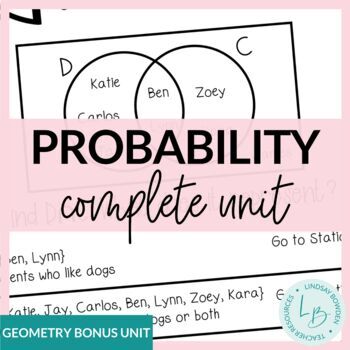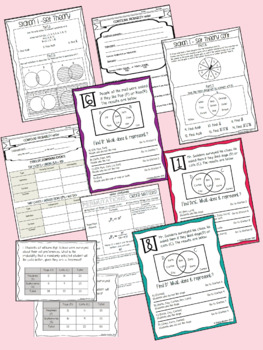Probability Unit Bundle
- Zip
What educators are saying
Products in this Bundle (8)
showing 1-5 of 8 products
Bonus
Description
Get a complete High School Compound and Conditional Probability unit including lessons on set theory, outcomes, and basic, compound, and conditional probability, and more! These ready-to-use resources include everything you need to teach high school probability to your on-level or lower-level/special education class. Supplements would be needed for an honors class.
This is a bonus unit that's included in my Geometry Curriculum.
Each unit contains guided notes, practice worksheets for the classroom and/or homework, activities like task cards and scavenger hunts, editable posters, quizzes, editable study guides, and editable tests. This unit also contains all answer keys, a unit study guide, and a unit exam. This unit is print-and-go to make your life easier. Plus, students will love the organization of the guided notes and the engaging activities!
*Update: This unit now contains video lessons for every set of notes!*
Topics Covered:
- Set Theory (union, intersection, complement; Venn diagrams)
- Outcomes and Basic Probability (intro to probability with coins, dice; finding outcomes with Fundamental Counting Rule, tree diagrams)
- Compound Probability (independent, dependent, mutually exclusive, overlapping, Multiplication Rule, Addition Rule; frequency tables)
- Conditional Probability (Independent, dependent; frequency tables)
- BONUS: Notes & Worksheets on Permutations and Combinations
This Bundle Includes:
⭐️ Probability Notes (Includes all guided notes with keys for the entire unit AND practice worksheets!)
⭐️ Compound Probability Task Cards
⭐️ Conditional Probability Task Cards
⭐️ Probability Study Guide and Test
⭐️ Permutations and Combinations Notes & Worksheets
*NOTE: The Pacing Guide, activities, study guide, and test do not include permutations and combinations because they are not part of the probability unit in geometry for many states. However, the study guide and test are EDITABLE, so feel free to add permutation & combination questions!
⭐️ Pacing Guide and Teacher Tips
The video lessons cover each set of notes and can be used for flipped classroom, absent students, or when you have a sub.
Download each of the resource’s print version previews for real examples of what is included!
TEACHERS LIKE YOU SAID…
⭐️⭐️⭐️⭐️⭐️ Math Working Capitol. says, "There's just not much out there for high school probability. This unit has completely fixed that problem for me. On grade level and on standard. Can not thank you enough!"
⭐️⭐️⭐️⭐️⭐️ Tosha E. says, "I really enjoy the way the notes page is set up and then there are plenty of examples included. I also appreciate that the data is represented in a variety of ways so that students get used to venn diagrams, frequency tables, and word problems."
⭐️⭐️⭐️⭐️⭐️ Rachel L. says, "The notes are very well laid out, and the practice problems and activities flow well from the notes. Thank you for creating such a useful resource! You have saved me a lot of headaches. :)"
You may also like…
→ Distance Learning: Geometry Digital Activities Bundle
___________________________________
Copyright © Lindsay Bowden.
Permission to copy for single classroom use only. This product should only be used by the teacher who purchased it. This product is not to be shared with other teachers. Please purchase additional licenses if you intend to share this product or if this is to be used by more than one teacher.
Did you know?
You can receive TPT store credits to use on future purchases by leaving feedback on products you buy! Just click on "My Purchases" under "Buy"!
Connect with me!





